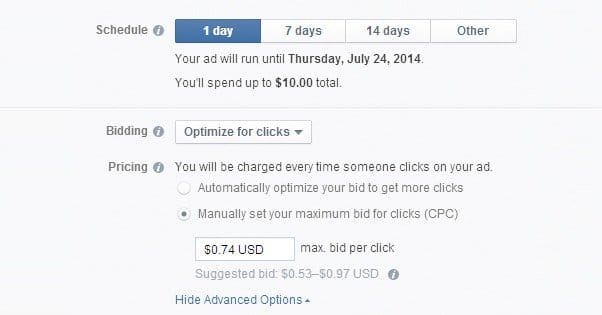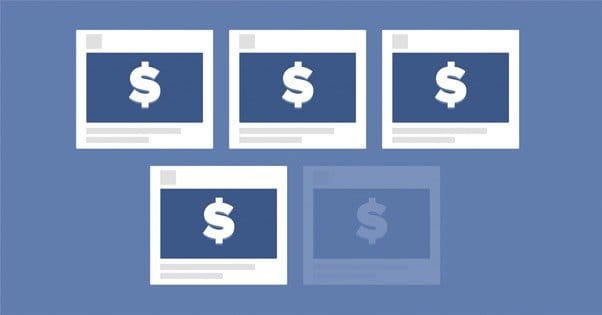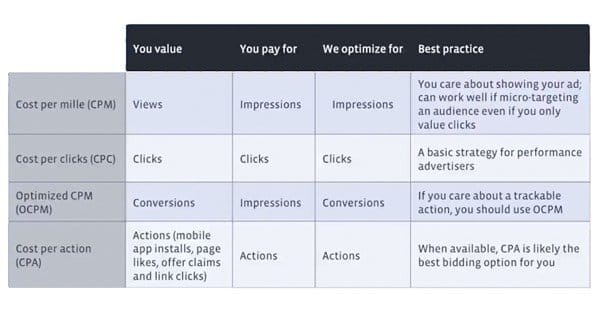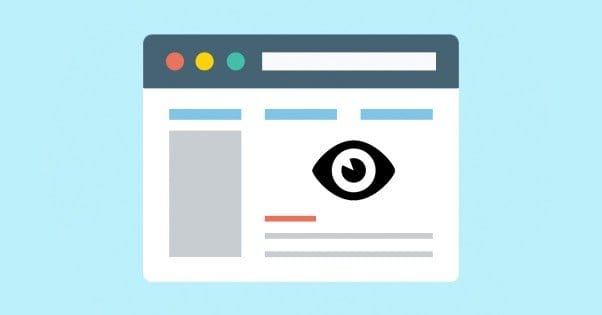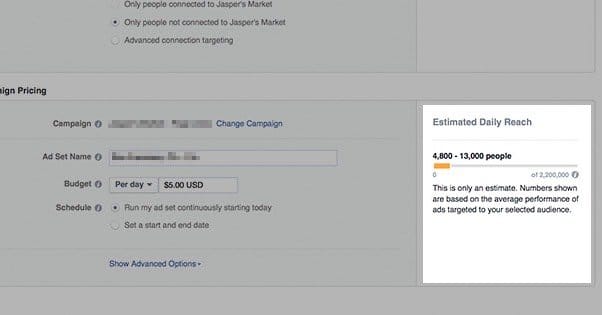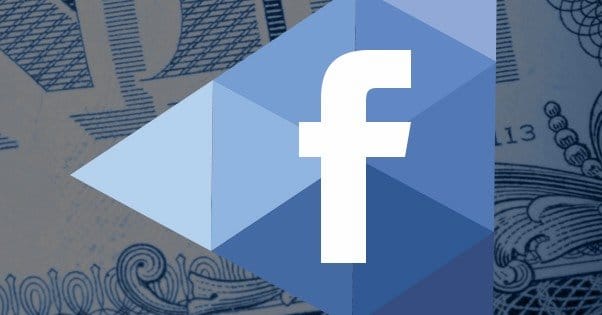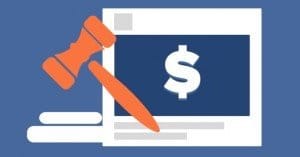 Written by ContentPowered.com
Written by ContentPowered.com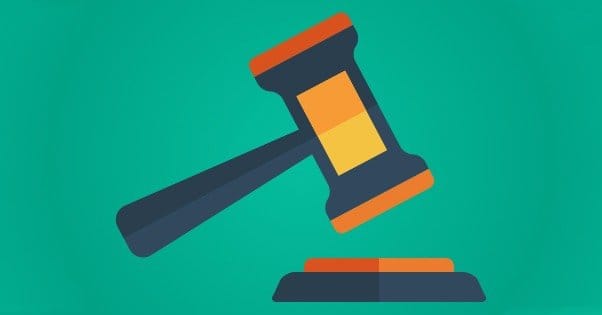
One of the most important aspects of Facebook ads, and one of the keys to paying as little as possible for your traffic, likes, and conversions, is targeting.
With proper targeting, your ads are like hyper-focused lasers into the brains of the people who are most interested in buying your products, while those around them remain oblivious. With poor targeting, you may as well feed your money into a paper shredded, for all the good it will do you.
That said, I’ve written about targeting before. There’s a ton of information out there about it. What I’m going to talk about today is the other aspect of ads, the place where your money actually matters directly. Bidding and budgets are the name of the game today.
The Facebook Auction
The first thing you need to realize in order to be successful on Facebook with ads is that the bids you place are just that; bids.
The ad marketplace is an auction. The item up for sale is a certain number of views for a selection of users. There are a billion users on Facebook, and that means there’s a lot of the commodity Facebook is trying to sell.
The thing is, that commodity varies wildly in quality in a lot of different situations. It’s all very contextual. For one thing, individual users have different values. A user that uses an adblocker is valueless to Facebook because they never see or click on ads. A user in Bangladesh is low value, because they’re likely to be part of a clickfarm, or otherwise unable to convert for a business one way or another.
Meanwhile, it also relates to business. If your business is selling shoes, a user that doesn’t care about or express an interest in shoes isn’t as valuable as a user who loves shoes and maintains a collection.
This is governed by two things; targeting and ad objective. When you look to bid with no targeting, all you’re asking is a share of the billion users on the site. When you use targeting, you narrow down your possible share of the commodity. Ad objectives then filter those users by those most likely to perform, and those are who you bid on.
This is why, even with a billion users on the site, you’ll have stiff competition for some niches and some actions. That’s where the auction competition comes in; the highest bidder gets their share, and on down the list, until the views run out. When that happens, the bidders left over get nothing.
Let’s look at the example below. Say there are five advertisers bidding on a very similar set of users. There are only four ad slots available. The top four bidders out of those five will get a share of the views, and the fifth will be left out until they bid more.
There’s one thing to note about pricing here; Facebook automatically charges you the bare minimum above what the second highest bidder maxes out at. That means if Advertiser A bids $5 for 1,000 views, and Advertiser B bids $10, B isn’t very likely to pay $10 for his thousand. More likely, he will pay closer to $6.
So why would B bid $10? Well, if B bids $6, and A decides to up their bid to $7, now A gets the lion’s share of the views. If B bids $10, and A ups theirs from $5 to $7, B still has the top, and A has to pay more for what they would have been getting at $5.
There are thus three things to remember about the absolute basics of the ad auction:
1. It’s an auction, meaning bids will change as others involved change theirs. If you’re not analyzing, testing, and changing your bids, you’re probably wasting money.
2. If you bid too low, you will probably still get some traffic, but it’s after the higher bidders take their pick. You get the bottom of the barrel.
3. If you bid too high, it doesn’t really matter; you’ll have the possibility of paying more than you otherwise would, but you don’t have to worry as much about being out-bid suddenly.
Facebook Bidding Strategies
There are four different bidding strategies on offer from Facebook, and they work in different ways for different reasons. Sometimes you’ll hear a marketer tell you to use one of another, but that’s always a situational judgment. All four of them are useful in various circumstances, though some are much more useful than others.
• CPM. This stands for Cost Per Mille, or Cost Per Thousand. It’s a bidding strategy based on getting you views to an objective, without regard for further conversions. You pay for impressions, Facebook optimizes for impressions, and that’s all you get. It doesn’t matter how few or how many people go on to convert; it doesn’t change your costs.
• CPC. This stands for Cost Per Click. You want clicks, you pay for clicks, Facebook optimizes for clicks; it’s all very standard. Again, conversions are not factored in to this calculation. A 0% conversion rate is entirely possible, and costs the same amount as a 100% conversion rate.
• OCPM. This stands for Optimized Cost per Mille. It’s also what most marketers tell you to use, when in doubt. You want conversions, but you don’t want to pay for the expensive cost per action model. You pay for impressions, but Facebook optimizes for conversions. Your ad is shown to people most likely to convert. On the other hand, since you’re still just paying for impressions, you could end up with no conversions and still have a bill.
• CPA. This stands for Cost Per Action, and is the most expensive but most reliable method for getting people to buy your products through Facebook. You want actions, like mobile app installs, offer claims, newsletter opt-ins and product sales. You pay for those actions, and Facebook optimizes for those actions. You don’t pay if the actions don’t happen.
Now, let’s take a look at each of them in a bit more detail to see which you should use, and when.
CPM is first, and it’s easily the hardest to use. It’s the cheapest, if you know what to do to use it properly, but that’s because it’s very easy to waste a lot of money on traffic that does nothing and goes nowhere. Essentially, you dump money into a firehose of traffic pointed at your site. From there, it’s all on you. If you targeted the wrong kind of traffic, you wasted money. If your sales funnel is blocked or broken, you wasted money. If you can’t get those users to convert, you wasted money.
Essentially, CPM is good if all you need is impressions, or if you have a lot of money to throw at it and even a single conversion is valuable enough to make your investment back. It can be good for building brand awareness, but it’s typically less valuable for actually selling products.
CPC is second, and it’s by far the most widely used type of bidding. That’s because impressions are free; every single user on Facebook could see your ad twice and you wouldn’t pay a cent.
On the other hand, every time someone clicks your ad, you pay. This applies to promoted posts in the news feed, which have links both to your main site and to your Facebook page. You want people to click through to your website, but if they click a link to your Facebook page instead, it still counts as a click and you still pay.
CPC gets better the better your click through rate, as well. Facebook vastly prefers showing ads that make them more money, so if your ad has a high CTR, it will be showed more often, because it earns them more money.
OCPM is, as I said, the one most people recommend, because it combines the cheap prices of CPM and the action-based optimization of CPA. You have a few options within OCPM for your optimization strategy. You can optimize for site conversions, site clicks, engagement, reach, likes, app installs, and basically anything that has an objective on Facebook.
OCPM is going to be more expensive than CPM, of course, but it will be less than CPA. It should also have a higher chance of generating actual conversions, so it’s typically the most beneficial mode to select.
CPA is the most expensive, but that’s because you’re paying for specific actions. This is where you have to make a calculation based on experimental data. How much does it cost to get a conversion through CPA bidding, and how much does that conversion make you in profit? If you’re losing money in the transaction, CPA is not for you.
Daily Unique Reach
There’s another form of optimization recently added to Facebook, and that’s optimizing for daily unique reach. Essentially, this makes Facebook show your ad to as many people as possible within your targeting, but sets frequency to a cap of 1. No one will see your ad more than once per day, no matter how high your budget.
Think of it like an unfiltered sort of CPM. Facebook isn’t careful about picking and choosing the right people who are most likely to convert on your ads; they’ll be showing it to anyone who comes along. This makes your targeting more important than ever, because if you’re off about your targeting, you’re showing your ads to people who don’t care.
If you’re very well situated, with a very compelling offer and a very successful sales funnel, this can be an extremely good way to get a lot of people to convert for a very small amount of money. Conversely, of course, a bad offer, bad funnel and bad ad will just throw away your budget.
Picking What to Use
So, what do you optimize for, and when do you pick it? What type of bidding strategy is best for which scenario?
CPA is generally the best when you want a specific outcome and you don’t want to pay for people to window shop. It’s great for cases where you’re getting people to install apps, engage with posts, or buy products from your website. It’s not very good for brand awareness or getting a significant volume of traffic to your site, your Facebook page, or an event page.
Optimizing for reach is the exact opposite. It’s only good for raising brand awareness or awareness of an event, and it’s only really good when what you’re looking to get out of it is intellectual. If you’re looking for conversions, you’re not looking for reach-based optimization. Consider it similar in many ways to a flyer campaign or a mass mailer.
CPC is ideal for engagement and followers, but not for anything that sends people to your website. It’s easy to get someone on Facebook to like a page or to share a post, but it’s a lot harder to send them off Facebook and get them to do something. There’s a certain amount of signal loss in terms of what the user is going to do when they get there, and it’s not always what you want them to do.
CPM is pretty rarely useful, and it’s only really useful when you just want to get your website in front of as many faces as possible, as often as possible, for as cheap as possible. You will have to watch your frequency carefully, because if you’re running ads in the sidebar, it can end up showing them to the same user five or six times a day. This is pretty wasteful, so only let it happen if you have a good reason.
How Much to Pay
So, all of this is great in theory, but how much should you bid? What costs are associated with what bidding strategies, and what budgets should you use?
The first rule of thumb is to always set budget limits at the max you’re willing to spend. A budget limit is not a bid, though; it’s a limit on daily ad spend. If you set a budget of $50, you’ll spend it all on 5x $10 CPA actions, or on 500x 50-cent clicks.
The research I’m going to reference for this section comes from Facebook pro Jon Loomer, and you can find more detail here. Before you dig in, though, always remember that costs can vary. Your business might have a niche appeal that makes one type of action much cheaper than otherwise is average, for example. The prices I’m going to list are average prices for different goals, typically using CPM, OCPM, or CPA.
The first goal is to increase page likes. Usually, the best audience to target for off-site actions like conversions are the people who follow your page, because you know they’re already interested in what you have to say. That means the first step to a solid targeted audience is to grow your Facebook followers.
The average here is anywhere from 20 cents to $1 per like. Typically, at lower volumes and for smaller pages, likes will be cheaper. It’s only once you grow enough that it becomes difficult to find more relevant followers that the cost goes up.
So, if you want 200 likes, consider bidding around 20-50 cents per like. If you want a few thousand likes, consider upping the bid to $1. Remember, of course, that your bid can be higher than you actually end up paying; it’s just what you’re willing to pay to out-bid everyone else.
Promoting posts to reach a wider audience typically uses engagement or follower building objectives, and they’re generally CPM. This means you can get quite a bit of fan engagement for relatively cheap. Loomer predicts that $100 can buy you exposure to 100,000 fans, assuming you have that many. Keep in mind, though, that you’ll only get clicks out of about 20% of the people you reach via a promoted post.
For example, if your CPM is $1 to reach 1,000 people, that’s nice, but only about 200 of them will actually click and engage. If you want to actually get 1,000 people to click and engage, you’ll need to reach closer to 5,000 people. Adjust your bidding accordingly.
What about conversions? I can’t give you a good number for off-site conversions, unfortunately. The reason for this is because of how personal it is for every business. It’s a lot easier to sell a $5 product than it is to sell a $100 product, so the CPA for the $5 product is going to be cheaper. That’s primarily due to the click-through rate and the volumes you can put up. On the other hand, you don’t necessarily need a large volume or a high CTR to make money out of a product that sells for $100. Any cost per action under the profit you get from a sale is a valid bid.
